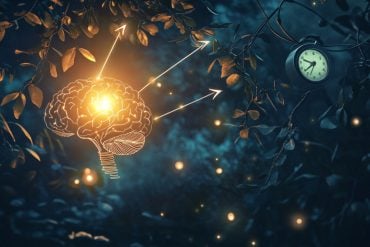Summary: Study reveals how the optimum amount of artificial bright light required during the day and evening to support healthy sleep, daytime alertness, and healthy bodily rhythms.
Source: PLOS
The light we experience across our daily lives has a major influence on our body rhythms. Modern lifestyles, with 24-hour access to electric light and reduced exposure to natural daylight, can disrupt sleep and negatively impact health, well-being, and productivity.
A new report in PLOS Biology addresses the issue of exactly how bright lighting should be during the day and in the evening to support healthy body rhythms, restful sleep, and daytime alertness.
Professors Timothy Brown from the University of Manchester, UK, and Kenneth Wright from the University of Colorado Boulder, US brought together an international body of leading scientific experts to agree the first evidence-based, consensus recommendations for healthy daytime, evening, and nighttime light exposure.
These recommendations provide much needed guidance to the lighting and electronics industries to aid the design of healthier environments and to improve how we light our workplaces, public buildings, and homes.
A key question tackled by the new report was how to properly measure the extent to which different types of lighting might influence our body rhythms and daily patterns of sleep and wakefulness.
Light affects these patterns via a specialized type of cell in the eye that uses a light sensitive protein, melanopsin, that is distinct from the proteins in the rods and cones that support vision (and upon which traditional ways of measuring “brightness” are based).
Since melanopsin is most sensitive to light in a specific part of the visual spectrum (blue-cyan light), the new recommendations used a newly-developed light measurement standard tailored to this unique property, melanopic equivalent daylight illuminance.
Analysis of data across a range of laboratory and field studies proved that this new measurement approach could provide a reliable way of predicting the effects of light on human physiology and body rhythms and could therefore form the basis of widely applicable and meaningful recommendations.

An important next step will be integration of the recommendations into formal lighting guidelines, which currently focus on visual requirements rather than effects on health and well-being.
Additionally, increasing sophistication in LED lighting technology and the availability of low-cost light sensors are expected to increase the ease with which individuals can optimize their personal light exposure to best support their own body rhythms in line with the new recommendations.
Brown adds, “These recommendations provide the first scientific consensus, quantitative, guidance for appropriate daily patterns of light exposure to support healthy body rhythms, nighttime sleep and daytime alertness. This now provides a clear framework to inform how we light any interior space ranging from workplaces, educational establishments and healthcare facilities to our own homes.”
About this circadian rhythm research news
Author: Press Office
Source: PLOS
Contact: Press Office – PLOS
Image: The image is in the public domain
Original Research: Open access.
“Recommendations for daytime, evening, and nighttime indoor light exposure to best support physiology, sleep, and wakefulness in healthy adults” by Brown TM, Brainard GC, Cajochen C, Czeisler CA, Hanifin JP, Lockley SW, et al. PLOS Biology
Abstract
Recommendations for daytime, evening, and nighttime indoor light exposure to best support physiology, sleep, and wakefulness in healthy adults
Ocular light exposure has important influences on human health and well-being through modulation of circadian rhythms and sleep, as well as neuroendocrine and cognitive functions.
Prevailing patterns of light exposure do not optimally engage these actions for many individuals, but advances in our understanding of the underpinning mechanisms and emerging lighting technologies now present opportunities to adjust lighting to promote optimal physical and mental health and performance.
A newly developed, international standard provides a SI-compliant way of quantifying the influence of light on the intrinsically photosensitive, melanopsin-expressing, retinal neurons that mediate these effects. The present report provides recommendations for lighting, based on an expert scientific consensus and expressed in an easily measured quantity (melanopic equivalent daylight illuminance (melaponic EDI)) defined within this standard.
The recommendations are supported by detailed analysis of the sensitivity of human circadian, neuroendocrine, and alerting responses to ocular light and provide a straightforward framework to inform lighting design and practice.






